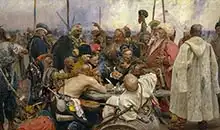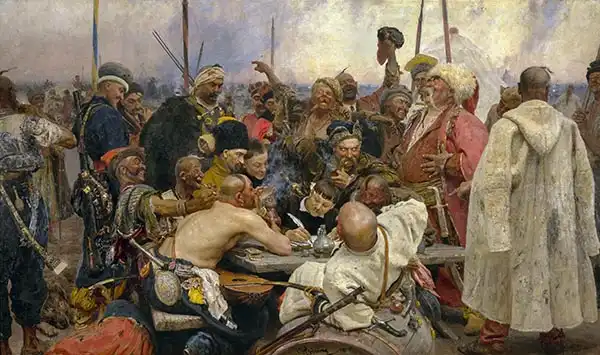About this finishing
Print. The image is printed on the top quality 10-ink HP Z9PS printer on HP matte 270 g / m2 paper. You can choose any size to an accuracy of 1 cm. A margin of 5 cm around the image is added to the size of the motif.


You can find a detailed description about our finishings
here.
Reply of the Zaporozhian Cossacks
Date:
1878-1891Medium:
oil on canvasDimensions:
217 x 361This painting is known for its humorous and provocative character and was an inspiration for many later artists. It also reflects a historical event when the Zaporozhian Cossacks wrote a sarcastic letter to the Turkish Sultan during the conflicts between Russia and the Ottoman Empire. The painting is now in the Tretyakov Gallery in Moscow and is one of
Ilya Repin's most famous works.
The painting depicts a group of Zaporozhian Cossacks sitting at a table and writing a letter to the Turkish Sultan Mehmet IV. They are surrounded by alcoholic beverages and full of enthusiasm.
The characters in the painting are distinctive and diverse. Each Cossack has his own personality and expression, which contributes to the overall humor and character of the picture. Some of them have funny and provocative views. The main point of interest of the painting is the large sheet on which the Cossacks are currently writing a letter to the Sultan. This letter is comic in nature and contains vulgarities and insults towards the Sultan.
Repin painted picture Reply of the Zaporozhian Cossacks in 1878-1891. Prevailing color of this fine art print is vivid and its shape is landscape. Original size is 217 x 361. This image is printed on demand - you can choose material, size and finishing.
Ilya Yefimovich Repin (1844-1930). Russian
Realistic painter and sculptor. After the October revolution, he was wrongly presented as part of the infamous art movement called Socialist Realism. He graduated from the Academy in St. Petersburg, and lived in Italy and France. After his return to Russia, he worked in Moscow, from 1882 again in St. Petersburg, and from 1900 in the Finnish Kuokkala. He was influenced by
Impressionism, which he encountered while studying in Paris. In the long-term, his style was closest to
Rembrandt and he never became an Impressionist. He painted mostly scenes from the lives of ordinary and poor people, but also depicted former elite and intelligentsia (the Imperial family or Tolstoy). Among his best-known images is
Barge Haulers on the Volga, in which he captured the conditions and the hard work of Russian serfs. He did not want to have anything to do with the revolution of 1917, and he did not paint revolutionary themes at all. He died in 1930 in Finland (he never wanted to go back to Russia). The Finnish city of Kuokkala was renamed Rjepino during the Soviet occupation of Finland.


